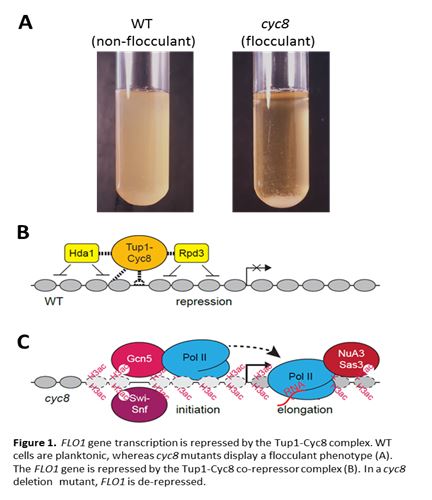
Alastair Fleming
Trinity College Dublin, Ireland
Title: Investigating the role of histone acetylation in the regulation of flocculation in Saccharomyces cerevisiae
Biography
Biography: Alastair Fleming
Abstract
Flocculation is a stress response whereby yeast cells adhere to each other to form an aggregation which offers protection to those cells within the ‘floc’ against the outside environment. The flocculation phenotype is important in biofilm formation and in industries such as brewing. Flocculation is mediated by the expression of cell wall proteins known as flocculins. These are lectin-like proteins which bind to the mannose residues in the cell walls of neighbouring yeast cells. The dominant flocculin gene in yeast is FLO1, which is regulated by the Tup1-Cyc8 co-repressor and the Swi-Snf co-activator. Although the mechanism of FLO1 repression has been well characterised, the mechanism of FLO1 de-repression is poorly understood. We show FLO1 de-repression in a cyc8 deletion strain is accompanied by Sas3 and Ada2-dependent histone H3 lysine-14 acetylation at the FLO1 promoter and ORF, together with Swi-Snf recruitment and histone eviction at the promoter. In the absence of Ada2 and Sas3-dependent H3 lysine-14 acetylation, Swi-Snf recruitment and histone eviction proceed at the de-repressed FLO1 promoter, but FLO1 transcription is reduced. Following the conditional depletion of Cyc8 via anchor-away, we show RNA polymerase II (RNAP II) is recruited to the de-repressed FLO1 promoter in a bi-phasic manner concomitant with a similar pattern of histone acetylation. In the absence of Sas3 and Ada2-dependent H3 acetylation, histone eviction and RNAP II recruitment at the FLO1 promoter still occur, however RNAP II is absent from the gene coding region. This suggests that in the absence of Cyc8, Sas3 and Ada2-dependent histone H3K14 acetylation is not required for histone eviction and RNAP II recruitment at the FLO1 promoter, but is required to enable transcription elongation to occur.
Recent Publications
- Young CP, Hillyer C, Hokamp K, Fitzpatrick DJ, Konstantinov NK, Welty JS, Ness SA, Werner-Washburne M, Fleming AB, Osley MA (2017) Distinct histone methylation and transcription profiles are established during the development of cellular quiescence in yeast. BMC Genomics. 18(1):107.
- Church M, Smith KC, Alhussain MM, Pennings S, Fleming AB (2017) Sas3 and Ada2(Gcn5)-dependent histone H3 acetylation is required for transcription elongation at the de-repressed FLO1 gene. Nucleic Acids Res.
- Haran J, Boyle H, Hokamp K, Yeomans T, Liu Z, Church M, Fleming AB et al. (2014) Telomeric ORFs (TLOs) in Candida spp. encode mediator subunits that regulate distinct virulence traits. PLoS Genet. 10(10).
- Fleming AB, et al. (2014) The yeast Cyc8-Tup1 complex cooperates with Hda1p and Rpd3p histone deacetylases to robustly repress transcription of the subtelomeric FLO1 gene. BBA-GRM. 1839(11):1242-55.
- Barski A, Chepelev I, Liko D, Cuddapah S, Fleming AB, et al. (2011) Pol II and its associated epigenetic marks are present at Pol III-transcribed noncoding RNA genes. Nat Struct Mol Biol. 17: 629-634


